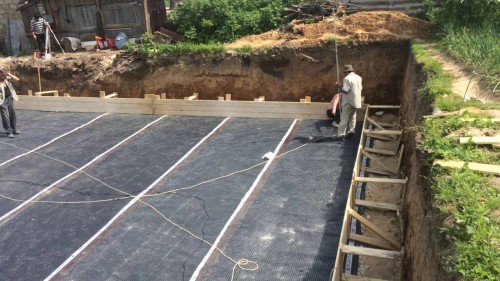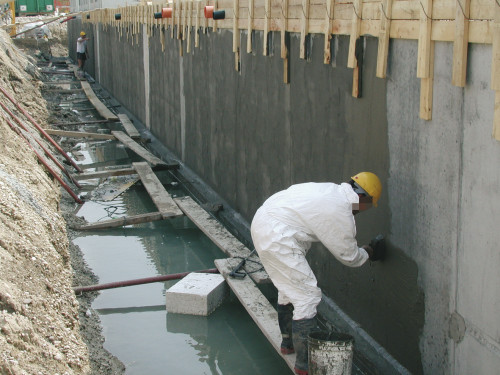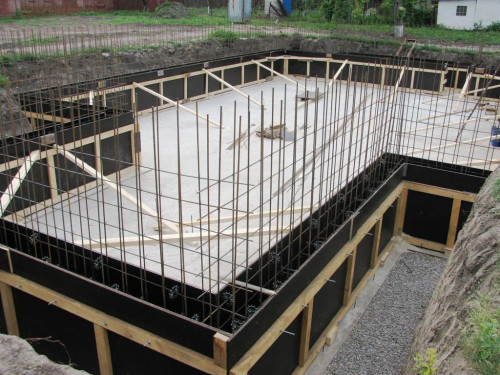When it comes to creating a foundation, experts perfectly understand the complexity and complexity of this process. The essence of such events is not only to create formwork and fill the structure with concrete. This process includes many responsible actions, on which the durability and general quality of the founding of the house may depend.
Content
It must be borne in mind that today on sale you can find a tremendous number of various materials necessary for high -quality construction. People who had not previously encountered construction, sometimes think that all these materials and resources that complement the construction process are an extra waste of money. However, the situation is somewhat different.
The waterproofing of the foundation is an extremely important aspect with which you can ensure a decent quality of the base. To begin with, it should be noted that no construction is complete without high -quality waterproofing. High stamps of concrete actively absorb moisture, and literally after a short period of time, the structure begins to lose its initial properties.
In this article, we will analyze all aspects associated with the waterproofing of formwork. Despite the many subtleties of the process, almost everyone can master this business and waterproof with their own hands.
The need for waterproofing formwork
Experienced builders are well aware that moisture is a colossal problem for any construction site. It can affect certain constructions minimally, but at the same time, the prolonged effect cannot be excluded, thanks to which irreparable changes can occur.
If we talk about the foundation, then this, as you know, is one of the most important building structures. If the foundation has some problems, then the whole structure may be under threat, no matter how large and reliable it may be. To ensure the reliability of the foundation, it is necessary not only to follow the subtleties of technology during construction, but also to pay attention to all surrounding factors.
If we talk about the waterproofing of the foundation, then the problem is often in groundwater, which in a short period of time can make the foundation almost unsuitable for further operation of the structure. Accordingly, it makes sense to do everything possible so that the base is in full protection. Moreover, it is necessary to regularly ensure that the very negative points do not become a surprise, otherwise it may be too late for some “rescue” events.
Here I would like to say that they use waterproofing material far from always. For example, if concrete of a low brand was used to create the foundation, then the water absorption of this design will be quite low, so the moisture will not be a serious problem. By the way, the grounds using low -quality concrete are found only on small buildings, therefore, in all other cases, waterproofing plays a key role.
In addition, it is known that the need for waterproofing is available only in certain climatic zones. For example, in places where rains regularly go - waterproofing is needed. And vice versa: there are areas where the climate is hot, and, accordingly, no factors associated with water or simply high humidity do not affect the foundation. You can pay attention to the fact that the foundations created in the territory of the CIS countries need waterproofing.
Again, if we talk about soil waters, the situation is in such a way that builders are trying to carry out any events in such areas. It often turns out that groundwater can completely destroy the entire construction project. Of course, this happens extremely rarely, therefore, often groundwater is slowly but confidently destroying the base.
Low temperatures are especially affected by all this. It turns out that water through the soil enters the concrete structure, after which, freezing, expanding and creating many problems.
Options for protecting the foundation from moisture influence
First you need to keep in mind that you can protect the foundation from the negative impact of water at once in two ways. The situation is that in certain cases one or the second method can be used, which allows you to extract maximum benefits.
- Concrete mixture. As you know, today for concrete structures you can use various components that can slightly improve the properties of the structure. Directly to protect against moisture, you can also use various components that exclude the need to use classical waterproofing. It should be noted that in order to obtain a qualitative result, there is a need to comply with all the intricacies of the technology. Practice shows that this is not always an easy task.
- Waterproofing layer. This is the same waterproofing that is known even for people who are rarely encountered with the construction process. Moreover, mastic, roller materials, as well as many other resources that are equipped separately from the concrete structure, can be used as isolation from moisture. Convenience is that such waterproofing can be easily replaced, and also applied to almost any surface.
Waterproofing of formwork
If we are talking about a question related to the waterproofing of the foundation, it is advisable to carry out this process on the basis of formwork. The bottom line is that when arranging waterproofing material, you can be sure that the concrete mixture, which will be later filled, will not go beyond this design. Obviously, it will not work in any other way to carry out a qualitatively waterproofing work, since it will certainly not work to completely cover the entire area of \u200b\u200bthe foundation.
It is also necessary to pay attention to the fact that often the formwork may not be of the highest quality, and for the same reason the created waterproofing can either be damaged or simply have no effect. Therefore, during the construction process, every detail is important.
The choice of waterproofing materials
Obviously, the creation of waterproofing should take place even before the concrete structure was filled. Accordingly, we are talking about various materials that can be used for high -quality waterproofing.
If we are talking about the acquisition of rolled material, then its width should be no more than 30 cm. The joints between the stripes of the material should be smeared with bitumen mastic. The most interesting thing is that often as an additional component of waterproofing, an ordinary plastic film is used, which is simply located on top of the main material.
- Environmental materials. These are one of the most common waterproofing materials. It is obvious that it is the layer of a particular material that has the greatest effect when protecting the concrete structure from moisture. This is not always the case, but exceptions are extremely rare. All these materials are available on the basis of bitumen and other components that can protect the structure from an aggressive environment. Manufacturers of such products are simply a tremendous amount, so finding high -quality goods will not be difficult. The application of these materials is most often carried out using a gas burner, but there are other application options.
- Crystal materials. These are also quite common materials. Most often these are bitumen or polymer mastics, which are simply applied to a certain layer on the surface. It can also be emulsions, viscous solutions and much more. The application of these materials occurs either using sprayers or using brushes and spatulas.
- Plastering materials. Using such resources for waterproofing the foundation, by and large, is pointless. We are talking about creating a mineral-cement layer, which includes the corresponding additives, which easily resist the action of moisture. Practice shows that such an insulating material cannot provide full protection of the construction structure, but with low humidity this is a good option.
It is impossible to unequivocally say which of the above waterproofing options is the best. Of course, plastering isolation is not the best choice for the foundation, but between the first two materials you can choose without any problems.
Of course, this article is about the waterproofing of formwork, so it makes sense to use the pasted materials to obtain the high quality of the work.
The process of waterproofing formwork
First of all, you need to understand that the meaning in waterproofing is made only with non -removable formwork. The bottom line is that with a qualitatively created insulation, you can safely fill with concrete, after which the structure will be fully protected from external factors associated with the action of moisture.
You also need to understand that in order to obtain maximum waterproofing efficiency, the material must have direct contact with a monolithic structure. Accordingly, in order to meet this requirement, you must first equip the insulation in the formwork, and then fill it. Under ordinary conditions, when the concrete structure is already available, there is a need for surface covering with special primer compounds.
- First of all, as we have already said, the creation of formwork takes place. Obviously, for the use of waterproofing, as well as to ensure its durability and other positive characteristics, the formwork should be of high quality. We are talking about even boards, the absence of cracks, gaps and other aspects associated with the general condition of the structure. Often, it is precisely the wood components of the structures in budget construction, which is why it turns out that some serious flaws may be present. Do not forget that the formwork should withstand a large volume of concrete mixture, since filling can occur with a sufficiently high intensity.
- Well, the next step is directly applying waterproofing. Environmental material should be located inside the formwork. The most important thing is to monitor the state of waterproofing, since many flaws of formwork, as we have already said above, can significantly affect the quality of work. After a thorough check of the surface condition, you can continue the measures. It must be remembered that after applying the glow waterproofing, the joints between the stripes must be covered with appropriate compounds. Often this aspect becomes decisive when receiving high -quality waterproofing.
The rest of the details
I must say that in this case, much depends directly on the scale of the work. If we are talking about the construction of a small private house, then it is quite possible that the quality of the work carried out related to the waterproofing of the structure does not matter. At the same time, it makes sense to pay attention to many other aspects of the construction process.
If the construction occurs on a truly large scale, then the involvement of specialists is often required. It is worth paying attention to the fact that large construction is something really responsible, where poor -quality waterproofing can lead to enormous consequences. In this case, we are talking about numerous details associated directly with the quality of the use of waterproofing materials.
If everything is done as efficiently as possible, then the water will not make any problems of the concrete structure. On the other hand, if the material has some flaws, then gradually they will increase their scale and simply destroy the structure. In some cases, this can happen so slowly that it will not have any effect.
In addition to the fact that waterproofing of formwork needs to be carried out, it is often required to continue this trend and carry out work related to isolation of the rest of the foundation. Builders are well aware that the need to protect the basement of the foundation from the action of moisture also exists, and often it is on this component of the base that the maximum effect of water or moisture occurs. Thus, comprehensive waterproofing should fully protect the base of the house from moisture, thereby creating the most favorable conditions for the existence of the structure. Again, it must be remembered that the durability of the components of the building structure has a colossal value, so various insulating materials are necessary. All measures related to waterproofing can be spent a lot of money, but this is worth it, since we are talking about the priority aspects of building structures.













